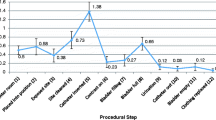Abstract
Background
Various strategies to mitigate children’s distress during voiding cystourethrography (VCUG) have been described. Sedation with nitrous oxide is comparable to that with oral midazolam for VCUG, but a side-by-side comparison of nitrous oxide sedation and routine care is lacking.
Objective
The effects of sedation/analgesia using 70% nitrous oxide and routine care for VCUG and radionuclide cystography (RNC) were compared.
Materials and methods
A sample of 204 children 4–18 years of age scheduled for VCUG or RNC with sedation or routine care were enrolled in this prospective study. Nitrous oxide/oxygen (70%/30%) was administered during urethral catheterization to children in the sedated group. The outcomes recorded included observed distress using the Brief Behavioral Distress Score, self-reported pain, and time in department.
Results
The study included 204 patients (99 nonsedated, 105 sedated) with a median age of 6.3 years (range 4.0–15.2 years). Distress and pain scores were greater in nonsedated than in sedated patients (P < 0.001). Time in department was longer in the sedated group (90 min vs. 30 min); however, time from entry to catheterization in a non-imaging area accounted for most of the difference. There was no difference in radiologic imaging time.
Conclusion
Sedation with nitrous oxide is effective in reducing distress and pain during catheterization for VCUG or RNC in children.


Similar content being viewed by others
References
Stashinko EE, Goldberger J (1998) Test or trauma? The voiding cystourethrogram experience of young children. Issues Compr Pediatr Nurs 21:85–96
Phillips D, Watson AR, Collier J (1996) Distress and radiological investigations of the urinary tract in children. Eur J Pediatr 155:684–687
Merritt KA, Ornstein PA, Spicker B (1994) Children’s memory for a salient medical procedure: implications for testimony. Pediatrics 94:17–23
Elder JS (2005) Imaging for vesicoureteral reflux – is there a better way? J Urol 174:7–8
Akil I, Ozkol M, Ikizoglu OY et al (2005) Premedication during micturating cystourethrogram to achieve sedation and anxiolysis. Pediatr Nephrol 20:1106–1110
Stokland E, Andréasson S, Jacobsson B et al (2003) Sedation with midazolam for voiding cystourethrography in children: a randomised double-blind study. Pediatr Radiol 33:247–249
Elder JS, Longenecker R (1995) Premedication with oral midazolam for voiding cystourethrography in children: safety and efficacy. AJR 164:1229–1232
Krauss B, Green SM (2000) Sedation and analgesia for procedures in children. N Engl J Med 342:938–945
Jones RD, Visram AR, Kornberg JP et al (1994) Premedication with oral midazolam in children: an assessment of psychomotor function, anxiolysis, sedation and pharmacokinetics. Anaesth Intensive Care 22:539–544
Merguerian PA, Corbett ST, Cravero J (2006) Voiding ability using propofol sedation in children undergoing voiding cystourethrograms: a retrospective analysis. J Urol 176:299–302
Zelikovsky N, Rodrigue JR, Gidycz CA et al (2000) Cognitive behavioral and behavioral interventions help young children cope during a voiding cystourethrogram. J Pediatr Psychol 25:535–543
Phillips DA, Watson AR, MacKinlay D (1998) Distress and the micturating cystourethrogram: does preparation help? Acta Paediatr 87:175–179
Salmon K, McGuigan F, Pereira JK (2006) Brief report: optimizing children’s memory and management of an invasive medical procedure: the influence of procedural narration and distraction. J Pediatr Psychol 31:522–527
Butler LD, Symons BK, Henderson SL et al (2005) Hypnosis reduces distress and duration of an invasive medical procedure for children. Pediatrics 115:e77–e85
Webb MD, Moore PA (2002) Sedation for pediatric dental patients. Dent Clin North Am 46:803–814
Michaud L, Gottrand F, Ganga-Zandzou PS et al (1999) Nitrous oxide sedation in pediatric patients undergoing gastrointestinal endoscopy. J Pediatr Gastroenterol Nutr 28:310–314
Annequin D, Carbajal R, Chauvin P et al (2000) Fixed 50% nitrous oxide oxygen mixture for painful procedures: a French survey. Pediatrics 105:e47
Luhmann JD, Kennedy RM, Porter FL et al (2001) A randomized clinical trial of continuous-flow nitrous oxide and midazolam for sedation of young children during laceration repair. Ann Emerg Med 37:20–27
Burnweit C, Diana-Zerpa JA, Nahmad MH et al (2004) Nitrous oxide analgesia for minor pediatric surgical procedures: an effective alternative to conscious sedation? J Pediatr Surg 39:495–499
Fauroux B, Onody P, Gall O et al (2004) The efficacy of premixed nitrous oxide and oxygen for fiberoptic bronchoscopy in pediatric patients: a randomized, double-blind, controlled study. Chest 125:315–321
Fishman G, Botzer E, Marouani N et al (2005) Nitrous oxide-oxygen inhalation for outpatient otologic examination and minor procedures performed on the uncooperative child. Int J Pediatr Otorhinolaryngol 69:501–504
Schmit P, Sfez M (1997) Management of anxious and painful manifestations in pediatric uroradiology. J Radiol 78:367–372
Keidan I, Zaslansky R, Weinberg M et al (2005) Sedation during voiding cystourethrography: comparison of the efficacy and safety of using oral midazolam and continuous flow nitrous oxide. J Urol 174:1598–1600
Kanagasundaram SA, Lane LJ, Cavalletto BP et al (2001) Efficacy and safety of nitrous oxide in alleviating pain and anxiety during painful procedures. Arch Dis Child 84:492–495
Frampton A, Browne GJ, Lam LT et al (2003) Nurse administered relative analgesia using high concentration nitrous oxide to facilitate minor procedures in children in an emergency department. Emerg Med J 20:410–413
American Academy of Pediatrics Committee on Drugs (1992) Guidelines for monitoring and management of pediatric patients during and after sedation for diagnostic and therapeutic procedures. Pediatrics 89:1110–1115
Tucker CL, Slifer KJ, Dahlquist LM (2001) Reliability and validity of the brief behavioral distress scale: a measure of children’s distress during invasive medical procedures. J Pediatr Psychol 26:513–523
Wong DL, Baker CM (1988) Pain in children: comparison of assessment scales. Pediatr Nurs 14:9–17
Houpt MI, Limb R, Livingston RL (2004) Clinical effects of nitrous oxide conscious sedation in children. Pediatr Dent 26:29–36
Gall O, Annequin D, Benoit G et al (2001) Adverse events of premixed nitrous oxide and oxygen for procedural sedation in children. Lancet 358:1514–1515
Wilson S (2000) Pharmacologic behavior management for pediatric dental treatment. Pediatr Clin North Am 47:1159–1175
Author information
Authors and Affiliations
Corresponding author
Rights and permissions
About this article
Cite this article
Zier, J.L., Kvam, K.A., Kurachek, S.C. et al. Sedation with nitrous oxide compared with no sedation during catheterization for urologic imaging in children. Pediatr Radiol 37, 678–684 (2007). https://doi.org/10.1007/s00247-007-0508-z
Received:
Revised:
Accepted:
Published:
Issue Date:
DOI: https://doi.org/10.1007/s00247-007-0508-z




